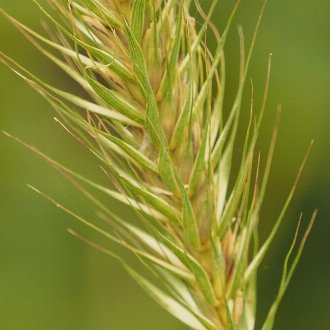Virginia Wildrye vs Southeastern Wildrye
This guide is under construction and has not been published yet. It may have errors. When in doubt, double-check other sources for definitive ID.These two species are often confused where their ranges overlap, as both have long, upright spikes. E. virginicus var. halophilus and E. virginicus var. jejunus are particularly easy to confuse with E. glabriflorus.
Virginia Wildrye (Elymus virginicus) | Southeastern Wildrye (Elymus glabriflorus) |
A perennial, cool-season bunchgrass found in moist, sunny to partly-sunny areas, native to almost all but the westernmost parts of North America. | A perennial cool-season bunchgrass native to the southeastern to south-central US, ranging onto drier sites than most Elymus species. |
Much narrower spike (usually 1-2.2mm wide) reflecting shorter awns which angle more towards the tip of the spike and spread less. Photo © Marilynn Miller, CC BY 4.0. | Much wider spike (usually 2.5-4mm wide) reflecting longer awns which angle outward more. Photo © Haley Daniels, CC BY 4.0. |
On E. virginicus var virginicus, the most widespread variety, base of spike is sheathed in the uppermost leaf. Photo © Reuven Martin, Public Domain. | Base of spike is almost always exposed, often separated from the uppermost leaf by a considerable distance. Photo © mefisher, Public Domain. |
Glume awns much shorter, usually 3-10mm long, rarely to 15mm. Awns short relative to the glume body. Photo © Zihao Wang, CC BY 4.0. | Glume awns much longer, usually 15-25mm long, rarely 10-30mm. Awns long relative to the glume body. Photo © Megan Kossa, CC BY 4.0. |
Spikelets closely pressed against the central stem, spreading at most at a slight angle. Photo © Zihao Wang, CC BY 4.0. | Spikelets spreading more from the central stem, at a wider angle. Photo © mefisher, Public Domain. |
References & External Resources
These short lists show only links helpful for ID. For a complete list of references and resources also covering other aspects of ecology, visit the links section of the full article on each plant, which is the first entry here.










